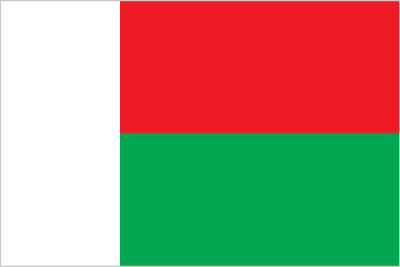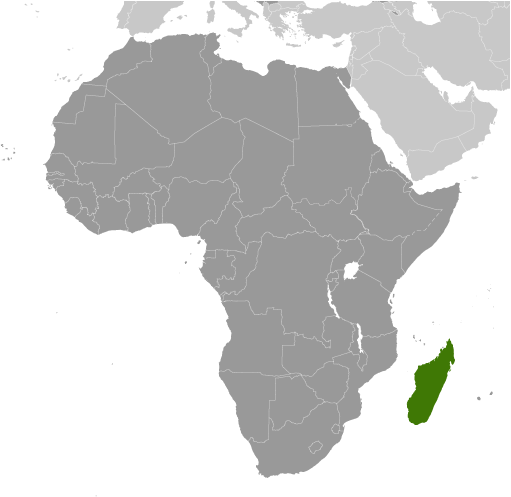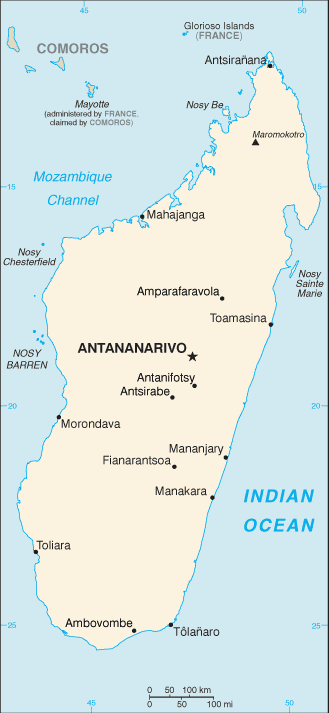|
Economy - overview:
|

|
|
After discarding socialist economic policies in the mid-1990s, Madagascar followed a World Bank- and IMF-led policy of privatization and liberalization that has been undermined since the start of the political crisis. This strategy placed the country on a slow and steady growth path from an extremely low level. Agriculture, including fishing and forestry, is a mainstay of the economy, accounting for more than one-fourth of GDP and employing 80% of the population. Exports of apparel boomed in recent years primarily due to duty-free access to the US, however, Madagascar's failure to comply with the requirements of the African Growth and Opportunity Act (AGOA) led to the termination of the country's duty-free access in January 2010 and a sharp fall in textile production. Deforestation and erosion, aggravated by the use of firewood as the primary source of fuel, are serious concerns. The current political crisis, which began in early 2009, has dealt additional blows to the economy. Tourism dropped more than 50% in 2009 compared with the previous year, and many investors are wary of entering the uncertain investment environment. Growth was anemic during 2010 to 2012 although expansion in mining and agricultural sectors is expected to contribute to more growth in 2013.
|
|
|
GDP (purchasing power parity):
|

|
|
$21.37 billion (2012 est.)
country comparison to the world: 128
$20.97 billion (2011 est.)
$20.6 billion (2010 est.)
note:
data are in 2012 US dollars
|
|
|
GDP (official exchange rate):
|

|
|
$10.05 billion (2012 est.)
|
|
|
GDP - real growth rate:
|

|
|
1.9% (2012 est.)
country comparison to the world: 142
1.8% (2011 est.)
0.4% (2010 est.)
|
|
|
GDP - per capita (PPP):
|

|
|
$1,000 (2012 est.)
country comparison to the world: 218
$1,000 (2011 est.)
$1,000 (2010 est.)
note:
data are in 2012 US dollars
|
|
|
GDP - composition by sector:
|

|
|
agriculture: 28.3%
industry:
16.5%
services:
55.2% (2012 est.)
|
|
|
Labor force:
|

|
|
9.504 million (2007)
country comparison to the world: 51
|
|
|
Population below poverty line:
|

|
|
50% (2004 est.)
|
|
|
Household income or consumption by percentage share:
|

|
|
lowest 10%: 2.2%
highest 10%:
34.7% (2010 est.)
|
|
|
Distribution of family income - Gini index:
|

|
|
47.5 (2001)
country comparison to the world: 28
38.1 (1999)
|
|
|
Investment (gross fixed):
|

|
|
18.7% of GDP (2012 est.)
country comparison to the world: 113
|
|
|
Budget:
|

|
|
revenues: $1.738 billion
expenditures:
$1.907 billion (2012 est.)
|
|
|
Taxes and other revenues:
|

|
|
17.3% of GDP (2012 est.)
country comparison to the world: 180
|
|
|
Budget surplus (+) or deficit (-):
|

|
|
-1.7% of GDP (2012 est.)
country comparison to the world: 78
|
|
|
Inflation rate (consumer prices):
|

|
|
9.2% (2012 est.)
country comparison to the world: 195
9.5% (2011 est.)
|
|
|
Central bank discount rate:
|

|
|
5% (31 December 2010 est.)
NA% (31 December 2009 est.)
|
|
|
Commercial bank prime lending rate:
|

|
|
42% (31 December 2012 est.)
country comparison to the world: 1
52.5% (31 December 2011 est.)
|
|
|
Stock of narrow money:
|

|
|
$1.823 billion (31 December 2012 est.)
country comparison to the world: 130
$1.445 billion (31 December 2011 est.)
|
|
|
Stock of broad money:
|

|
|
$2.926 billion (31 December 2012 est.)
country comparison to the world: 146
$2.223 billion (31 December 2011 est.)
|
|
|
Stock of domestic credit:
|

|
|
$1.349 billion (31 December 2012 est.)
country comparison to the world: 150
$1.048 billion (31 December 2011 est.)
|
|
|
Market value of publicly traded shares:
|

|
|
$NA
|
|
|
Agriculture - products:
|

|
|
coffee, vanilla, sugarcane, cloves, cocoa, rice, cassava (tapioca), beans, bananas, peanuts; livestock products
|
|
|
Industries:
|

|
|
meat processing, seafood, soap, breweries, tanneries, sugar, textiles, glassware, cement, automobile assembly plant, paper, petroleum, tourism
|
|
|
Industrial production growth rate:
|

|
|
2% (2010 est.)
country comparison to the world: 114
|
|
|
Current account balance:
|

|
|
-$2.322 billion (2012 est.)
country comparison to the world: 142
-$2.526 billion (2011 est.)
|
|
|
Exports:
|

|
|
$1.533 billion (2012 est.)
country comparison to the world: 149
$1.394 billion (2011 est.)
|
|
|
Exports - commodities:
|

|
|
coffee, vanilla, shellfish, sugar, cotton cloth, clothing, chromite, petroleum products
|
|
|
Exports - partners:
|

|
|
France 22.9%, Indonesia 15.5%, Singapore 6.7%, China 5.7%, Germany 5.5%, US 5% (2011)
|
|
|
Imports:
|

|
|
$3.876 billion (2012 est.)
country comparison to the world: 139
$3.765 billion (2011 est.)
|
|
|
Imports - commodities:
|

|
|
capital goods, petroleum, consumer goods, food
|
|
|
Imports - partners:
|

|
|
China 17.4%, France 13.3%, South Africa 5.7%, Singapore 4.9%, Bahrain 4.8%, Mauritius 4.6%, Kuwait 4.5%, India 4.1% (2011)
|
|
|
Reserves of foreign exchange and gold:
|

|
|
$1.294 billion (31 December 2012 est.)
country comparison to the world: 129
$1.279 billion (31 December 2011 est.)
|
|
|
Debt - external:
|

|
|
$2.631 billion (31 December 2012 est.)
country comparison to the world: 136
$2.362 billion (31 December 2011 est.)
|
|
|
Stock of direct foreign investment - at home:
|

|
|
$NA
|
|
|
Stock of direct foreign investment - abroad:
|

|
|
$NA
|
|
|
Exchange rates:
|

|
|
Malagasy ariary (MGA) per US dollar -
2,220 (2012 est.)
2,025.1 (2011 est.)
2,090 (2010 est.)
1,956.2 (2009)
1,654.78 (2008)
|
|
|
Fiscal year:
|

|
|
calendar year
|
|
|
|





 )
)



